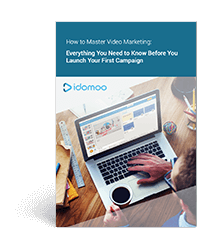Video remains one of the most engaging content formats. In fact, when asked how they’d like to learn about a product or a service, 69% of people say they’d prefer to watch a short video as opposed to 18% who’d prefer to read an article.
That said, video marketing has been around for a while, so it’s becoming increasingly difficult for brands to stand out simply by merit of having a video to show. One way you can make your videos more impactful is to make them data-driven.
How can you do this? Glad you asked.
There are two major ways you can use data to make your video marketing more effective:
- Using data to produce dynamic video content: You can customize your videos by using personal data for each individual who will watch your video. This means the video will be different for each viewer based on customer and contextual data. If you’re sharing a video with someone who isn’t a customer and you don’t have much data about them, you can also let them customize their video, which, in turn, helps you collect more of that critical first-party customer data. (More on this below.)
- Using data to track the ROI and effectiveness of your videos: Your job isn’t done when you launch your video marketing campaign. You also need to track how people respond and engage with your content. Below we look at some key marketing metrics to calculate your ROI, but in general, we’ve found that personalized videos can reduce customer acquisition costs by 50% and increase revenue by 5% to 15%.
If you’re producing ads, it’s likely you won’t have much data on your prospective customers, so there you might target segments with Dynamic Video Advertising on Facebook and Instagram. However, if you’re targeting current customers, you can make use of your existing data to appeal to their individual preferences and needs.
Take a look at this powerful Personalized Video by CCP Games for their Eve Online game. The technology is powered by Idomoo, but they synced their player data and gaming scenes to create a personalized year-in-review for every player.
Understanding Your Video Marketing Metrics
Tracking the right video metrics is crucial for understanding how your videos are performing and what changes you need to make to improve their effectiveness.
When it comes to metrics, video ads differ from general marketing videos in a few ways. While the key metrics for both are typically around engagement — clicking to view, watch time, and clicking the CTA — ads don’t usually perform as well. The average click-through-rate for video ads is 1.84%. If you think that’s high (and it’s one of the highest CTRs for digital ad formats), data-driven marketing videos regularly get 40% CTR, sometimes upward of 80%.
Why the disparity? It’s about the audience. Someone looking at a video ad likely has no connection to the brand. But a marketing video a customer receives in their app or via email is from a brand they already have a relationship with. And it’s this relationship that allows the video to be personalized because you know that customer.
Of course, you can’t forget about customer acquisition. Despite how much we advocate for customer care and CX, advertising has its place. And data-driven video ads still outperform regular video ads with 5x higher CTR.
Now, let’s dive right into the key video metrics you should pay attention to:
- Click-through-rate: This metric shows how many times people clicked on your video based on the number of times it was viewed. If your video was shown 100 times and people clicked on it 10 times, your CTR would be 10%.
- Completion rate: The average percentage of the video watched. At Idomoo, we’ve seen a 3x uplift in completion rates when videos are data-driven.
- Numbers of times watched: How many times a user watched the same video. We regularly see video marketing campaigns where customers watch their video 2-3 times as Personalized Videos resonate far more with viewers than generic ones.
- Clicks in videos: Overview of what links users clicked within the video. To be able to embed links, you’d need to use video technology that supports this functionality.
- Downloads or shares: How often users downloaded or shared the video. We’ve found, for example, that personalized recap videos (highlighting a customer’s past activities with the brand) have garnered a 5x increase in social shares.
- CTA conversions: How many times the CTA is clicked. This could also be calculated as a conversion rate based on the total number of viewers.
5 Ways to Make Your Videos Data-Driven
Now that you know a bit more about how data can help you make your videos stand out and what analytics you need to track, let’s look into five ways you can make your video marketing data-driven and boost ROI.
Put Your Customer Data to Good Use
Depending on how long a customer has been with you, you probably have a wealth of customer data sitting in your CRM waiting to be put to good use.
Sure, it’s great to send them a happy birthday note on their special day, but imagine how much more engagement you can drive if you use their data to speak to their needs. This means going beyond plugging in their first name or some other data point, like their most recent purchase.
Good video personalization takes into account the data that matters for that customer. For example, a customer who’s been with you for 20 years may need something different than someone who’s just signed up. Having this in mind will make your videos more relevant and engaging.
Think of it like a story. You’re putting your customer in the center of the narrative and showing them scenes that are relevant for them. This Personalized Video from Cedarville University illustrates how it works.
We’ve seen personalized education campaigns earn 7x higher CTR and a 46% conversion rate.
Another good example is using customer data to target customers when they abandon their shopping cart. Send that customer a Personalized Video showcasing the very items they looked at with a direct link to complete the shopping. Doing this soon after they’ve left your website is important as otherwise they might buy elsewhere. Fortunately, the video format makes your offer less likely to be ignored.
To sum up, the important thing to remember about making a data-driven video is to focus on the story you want to tell. You don’t need gobs of data. You just need to bring value to your customer, and personalization helps you do that.
Make Your Videos Contextual
Your data goes further when used in the right context. Things like the device the viewer is using, the location they’re streaming the video from, the time of day and so forth can all influence what type of content they should see. And that means the video needs to change based on those contextual parameters.
Here are some common examples:
- A video that prompts users to install an app can have the link to the app store when the viewer is on a mobile device.
- If your customer is in a cold location, show them offers related to winter wear or sunny getaways.
- If they open their video in the morning, your video can say “good morning” and address them by name.
Context isn’t just about the viewer. It’s also how the world (and data) around them changes. For example, your video can update based on changes to your products or sales. These contextual, data-driven videos are not only more relevant — they also save time and money that you or your team would otherwise have to spend manually creating variations of the same video.
As with customer data, when you’re thinking about contextual data, focus on what will be useful for the customer. What helps tell the story? What will help them take action, whether that’s making a purchase, sharing their video on social or simply setting up their online account?
This is where your past marketing and sales data can help, too. For example, if you know that bookings for a specific resort increase when the weather is sunny, you can use real-time weather data to determine when to show that resort (versus another destination) in your travel marketing video. If the weather changes, you simply show a different scene.
It’s all defined by logic in your video marketing platform, so you set the rules and watch your evergreen videos update in real time — endlessly.
Track Real-Time Analytics
Now let’s talk about analytics.
You know data matters. You would never run a Google Ads campaign without knowing how many clicks and conversions you were getting.
The same goes for video. You want to know how long customers watch your video, what they click in the video and how your video performs across different markets and audiences. Track analytics in real time so you can make changes on the fly.
Say you create a Personalized Video based on what customers looked at on your website. A couple of minutes after they leave your website, you send them an email with personalized video promoting those very same items at a discount. This has got to be a win, right?
Post on
Yet breaking down the data, you discover that people who opened the email via desktop responded really well and you got about a 45% conversion rate, yet those who accessd the video via mobile device converted only 15%. Why’s that? You can use this insight to change your video for mobile and make further improvements to drive conversions.
The type of analytics you track will depend on what you’re looking to achieve and the capabilities of your video platform. Idomoo, for instance, comes with a live analytics dashboard which allows users to filter content by regions, storyboards, tags and more to build comprehensive reports.
Use Videos To Collect More Customer Data
You can use your videos to collect even more customer data in a fun and engaging way. Instead of using surveys that nobody wants to fill in, what if you could make your videos interactive so customers want to share more information about themselves?
That’s now possible with Living Video. It’s easy. The video can have a set of fields where users can input their own data so they can generate an updated video in real time. They get a bespoke video. You get additional data you can use for future customer communications.
Why would a customer want to update their video? Any number of reasons:
- To see a product with their design
- To get a quote for a service
- To customize a video they can share with friends
- To uncover unique offers they qualify for
Here’s a quick example of how car shoppers might browse different pricing options within the same video. We see this technology on websites all the time, but it’s usually with still images. Now, the updated product (in this case, a car) and the related price are presented in video format — more immersive, shareable and actionable.
While text fields are a common way to allow user customization, you can also let viewers upload their own media, such as images or videos, change the soundtrack and more.
Maximize the Value From Data-Driven Video
Being data-driven with your video content marketing requires a holistic approach. You need to look at marketing data to make informed decisions about your campaign. But you also need to use customer data and sometimes contextual data as well to create relevant content.
This doesn’t have to be hard or time-consuming. Fortnite scripted, produced and distributed their data-driven video in just under 2 weeks, and it reached millions of players around the globe in 13 languages! And the results are stunning. We’ve seen Personalized Videos in the gaming industry boost engagement 10x and sales by nearly 70%.
Our proprietary, purpose-built rendering engine does the work for you. You connect it with your data source, and video scenes are immediately dynamic, able to change in real time so your video is up-to-the-minute accurate. This means you can use video to personalize the customer journey, from acquisition to onboarding to upselling, as easily as sending a personalized email. It boosts not only ROI but also customer loyalty and retention.
Want to find out more about how you can use data-driven videos to delight your customers and grow your business? Get in touch. We’ll show you how to take your video marketing to the next level.






